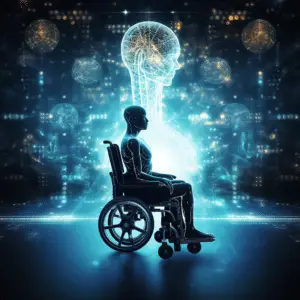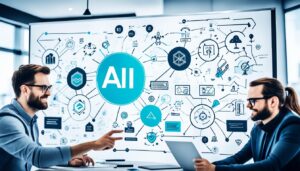
The Role of AI in Enhancing Accessibility for People with Disabilities
AI technology, Artificial Intelligence (AI) has emerged as a revolutionary technology with the power to transform numerous industries, and one area where its potential impact is immense is enhancing accessibility for people with disabilities.
“Artificial Intelligence has the power to break down barriers and create a more inclusive world for individuals with disabilities.” – Microsoft CEO, Satya Nadella
Empowering Individuals with Visual Impairments
AI-powered technologies offer new and exciting prospects for individuals with visual impairments. Through advancements in computer vision, object recognition, and machine learning algorithms, visually impaired individuals can have better access to information and enhanced independence in their daily lives.
For instance, AI can assist in reading and understanding text through optical character recognition (OCR) systems. These systems can scan and convert printed text into a digital format, enabling visually impaired individuals to access information that may not be available in braille or audio formats.
Additionally, AI can facilitate object recognition by interpreting visual content and describing it audibly. This ability allows visually impaired individuals to navigate their surroundings more confidently, identify objects, and even read signs and labels effectively.
Enabling Communication for Individuals with Speech Disabilities

AI technology are valuable in helping individuals with speech difficulties overcome communication barriers.Natural Language Processing (NLP) can empower individuals by turning text into spoken language or developing synthetic voices that closely match their own.
AI systems can improve communication and interaction for those with speech impairments by using voice recognition and synthesis techniques. Virtual assistants with language comprehension capabilities can simplify daily tasks including sending messages, making calls, and managing smart home devices using voice commands.
Enhancing Mobility and Accessibility
AI-driven technologies also have the potential to transform mobility and accessibility for individuals with physical disabilities. Intelligent systems can use machine learning algorithms and sensor data to assist with mobility and personalized navigation.
Predictive modeling algorithms can analyze data from various sources, such as GPS, mapping systems, public transportation schedules, and real-time traffic updates, to provide efficient and accessible travel recommendations. This empowers individuals with disabilities to plan their journeys with confidence, considering factors like accessible routes, availability of ramps and elevators, and estimated travel times.
Challenges and Future Perspectives
While AI offers immense potential in enhancing accessibility for people with disabilities, there are inherent challenges that need to be addressed. Ethical considerations, potential biases in AI algorithms, and privacy concerns must be thoroughly considered to ensure fair and inclusive technology for all users.
However, as AI technology continues to advance, it holds the promise of creating a more inclusive and accessible world. By leveraging the power of AI, we can break down barriers, overcome limitations, and empower individuals with disabilities to lead more independent, connected, and fulfilling lives.
“Inclusive design is designing for everyone, including people with permanent, temporary, situational, or changing disabilities” - Microsoft
How has AI technology been utilized to improve accessibility for individuals with disabilities?
AI technology has been utilized in various ways to improve accessibility for individuals with disabilities. Some of the key areas where AI has made a significant impact are:
1. Speech recognition and synthesis:
AI-powered virtual assistants and speech-to-text systems allow individuals with speech impairments or limited mobility to communicate more effectively. These technologies convert spoken words into text or vice versa, enabling individuals to interact with devices and communicate with others.
2. Computer vision and object recognition:
AI algorithms can analyze images or video streams to identify and describe objects, people, and surroundings. This technology helps individuals with visual impairments navigate their environment, recognize faces, and read text through text-to-speech conversion.
3. Natural language processing (NLP):
AI enables devices to understand and respond to human language, making it easier for individuals with disabilities to interact with technology. NLP allows individuals to control their devices, access information, and perform tasks through voice commands or text input.
4. Assistive technologies:
AI-powered devices and applications are used to augment the capabilities of individuals with disabilities. For example, AI-driven prosthetic limbs can provide more precise control and adaptation to users’ movements, while AI-enabled hearing aids can adapt to different sound environments and enhance hearing.
5. Accessibility improvements in digital content:
AI algorithms can automatically generate image descriptions, captions, and alternative text for digital content, making it more accessible to individuals with visual impairments. Such technologies can also provide suggestions for text formatting to enhance readability for individuals with reading difficulties.
6. Predictive analytics and smart home automation:
AI technology can learn users’ patterns, preferences, and needs to automate various tasks. This has made it easier for individuals with disabilities, such as mobility impairments, to control their living environment, manage appliances, and access essential services.
Overall, AI technology has provided significant advancements in improving accessibility for individuals with disabilities, empowering them to lead more independent and inclusive lives.
What challenges or limitations are associated with leveraging AI for enhancing accessibility and inclusivity for people with disabilities
There are several challenges and limitations associated with leveraging AI for enhancing accessibility and inclusivity for people with disabilities:
1. Data Bias:
AI systems may be trained on biased or incomplete datasets, leading to biased outcomes. This can disproportionately affect people with disabilities and lead to exclusion or discrimination.
2. Lack of Representation:
There is a lack of diversity and representation in the development and training of AI systems, including limited input from individuals with disabilities themselves. This can result in AI technologies that are not fully inclusive or do not address the specific needs of disabled individuals.
3. Ethical Concerns:
Ethical considerations regarding privacy, consent, and security arise with the use of AI in accessibility. There is a need for ensuring that the personal information and data of individuals with disabilities are protected and not misused.
4. Adaptability and Customization:
AI systems need to be adaptable and customizable to meet the diverse needs of individuals with disabilities. There can be limitations in developing AI technologies that can address individual preferences and varying levels of disabilities effectively.
5. Technical Limitations:
AI technologies are not always reliable or accurate, especially in complex scenarios. This can pose challenges for individuals with disabilities who heavily rely on these technologies for their daily activities.
6. Cost and Accessibility:
The adoption and implementation of AI technologies can be expensive, limiting accessibility for individuals with lower incomes or in resource-constrained environments. This can further exacerbate existing disparities in accessibility for people with disabilities.
7. Complexity and User-Friendliness:
AI systems often require technical expertise and complex setup, which can be a barrier for individuals with disabilities who may have limited technical skills or accessibility requirements.
Addressing these challenges and limitations requires a holistic and inclusive approach that involves collaboration between developers, researchers, policymakers, and disabled individuals themselves. Transparency, inclusivity, and careful consideration of ethical implications are crucial to ensure the effective and unbiased use of AI for enhancing accessibility and inclusivity.
In what ways has the role of AI positively impacted the lives of individuals with disabilities?

Artificial Intelligence (AI) has positively impacted the lives of individuals with disabilities in several ways:
1. Assistive technologies:
AI has enabled the development of advanced assistive technologies that can augment the abilities of people with disabilities. For example, AI-powered prosthetic limbs can provide enhanced functionality and intuitive control by analyzing neural signals. Similarly, AI-powered communication devices can enable individuals with speech disabilities to communicate effectively.
2. Accessibility:
AI has played a crucial role in improving accessibility for people with disabilities. For individuals with visual impairments, AI-based technologies like screen readers and image recognition systems help read text aloud and describe images, respectively. AI algorithms also facilitate automatic captioning for individuals with hearing impairments, enabling them to access audio content more easily.
3. Personalized support:
AI allows for the development of personalized support systems tailored to the specific needs of individuals with disabilities. AI-powered virtual assistants can provide personalized reminders, schedule management, and other assistance to individuals with cognitive impairments or memory difficulties. This technology helps them maintain independence, manage daily tasks, and improve overall quality of life.
4. Medical advancements:
AI has contributed to significant advancements in the field of healthcare, benefiting individuals with disabilities. For example, AI algorithms can analyze medical images and assist in early diagnosis of conditions like cancer, which can improve treatment outcomes for all individuals, including those with disabilities. AI can also assist in monitoring vital signs, alert individuals with chronic conditions or disabilities about potential health risks, and provide proactive recommendations.
5. Mobility and navigation:
Mobility assistance devices and navigation systems powered by AI have improved independence and freedom for those with physical limitations. Computer vision and sensor technology enable AI-powered wheelchairs to navigate obstacles and assist in maneuverability. Additionally, AI-enabled navigation apps provide accessible route mapping and real-time information, enabling those with disabilities to navigate their surroundings.
AI has tremendous positive effects for those with disabilities, including improved assistive technologies, accessibility, tailored support, medical developments, and mobility. AI advances disability-related sectors, promoting inclusion and improving the well-being of those with disabilities.









Thanks for sharing. I read many of your blog posts, cool, your blog is very good.
Can you be more specific about the content of your article? After reading it, I still have some doubts. Hope you can help me.